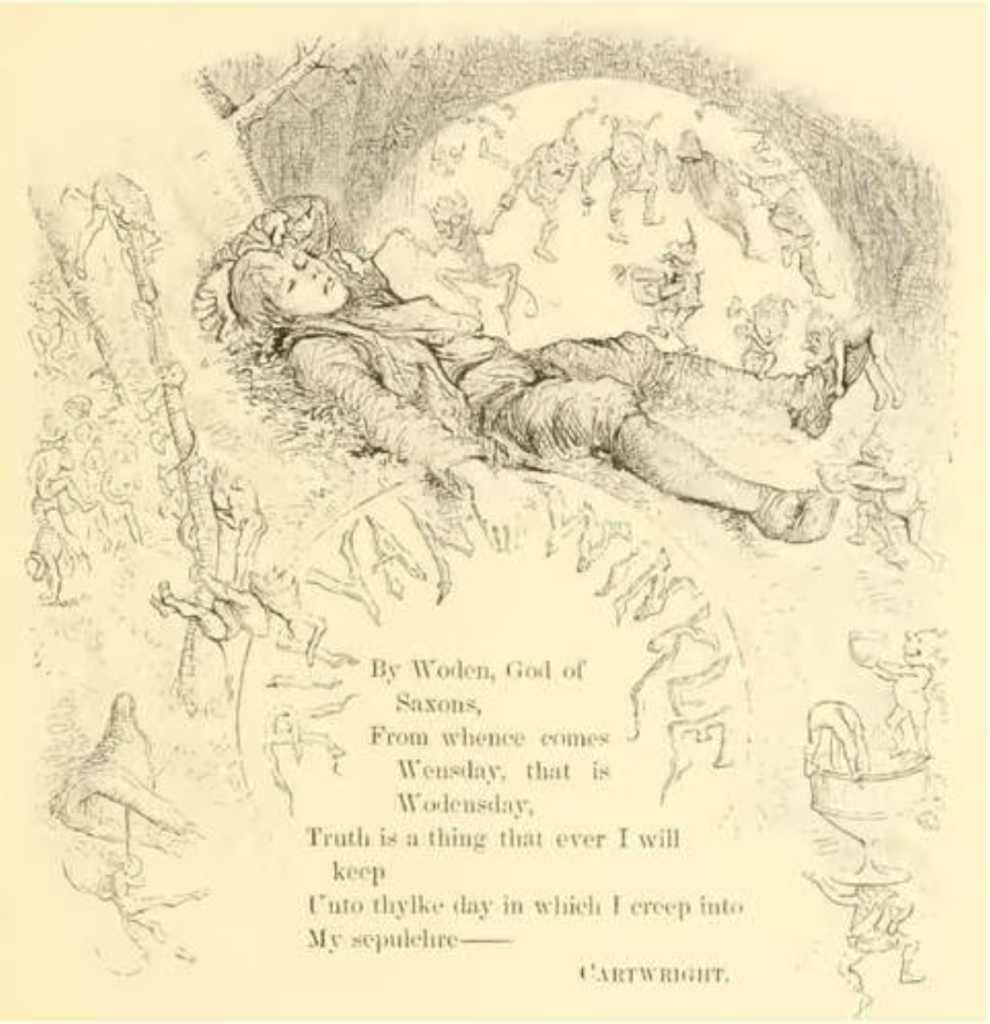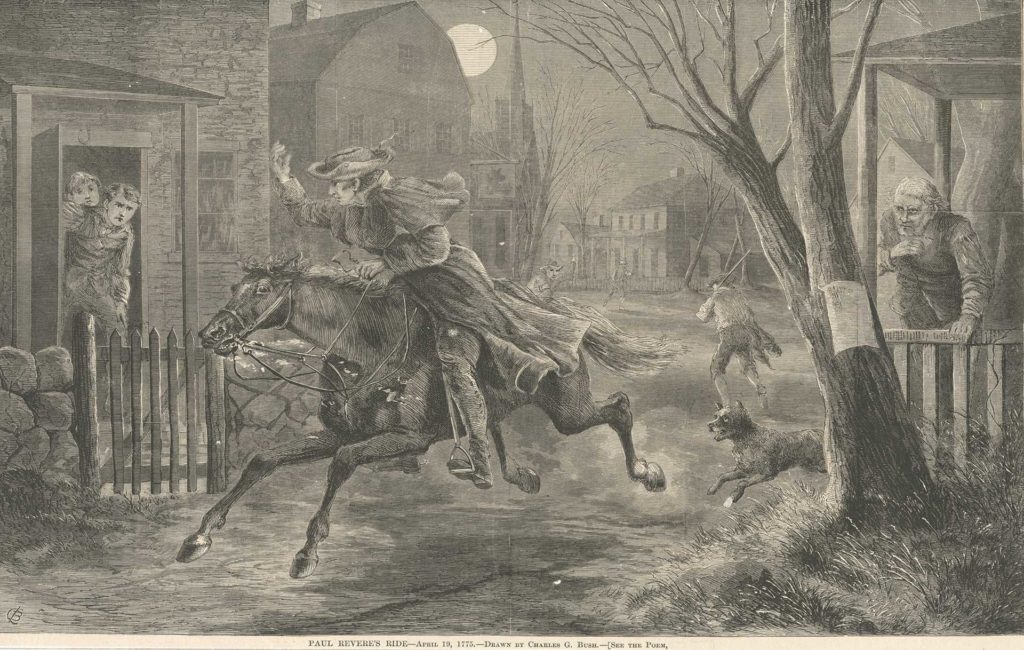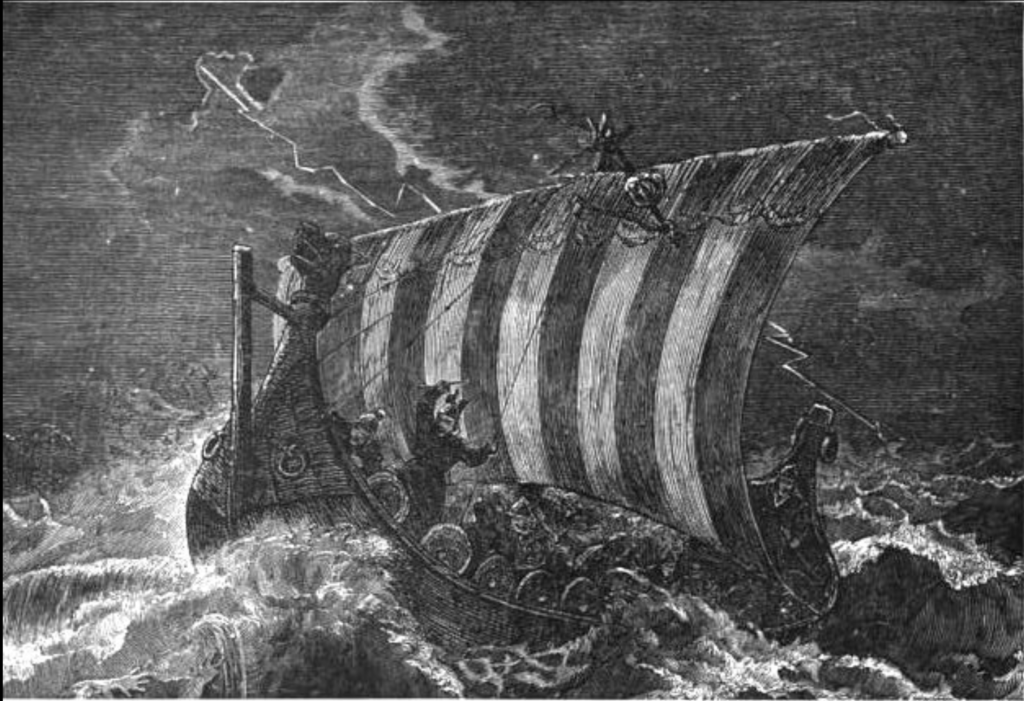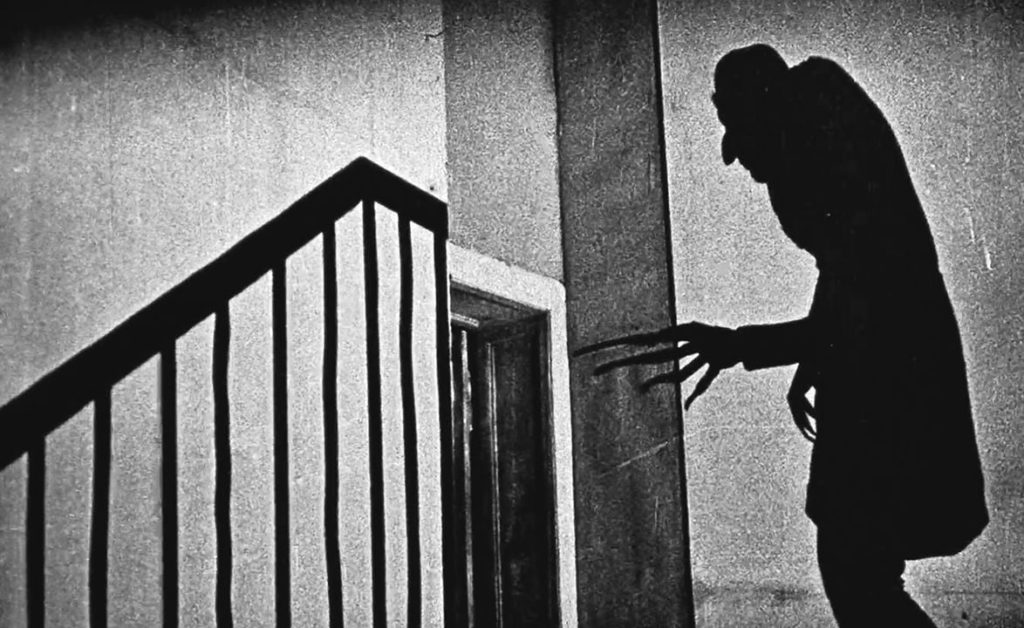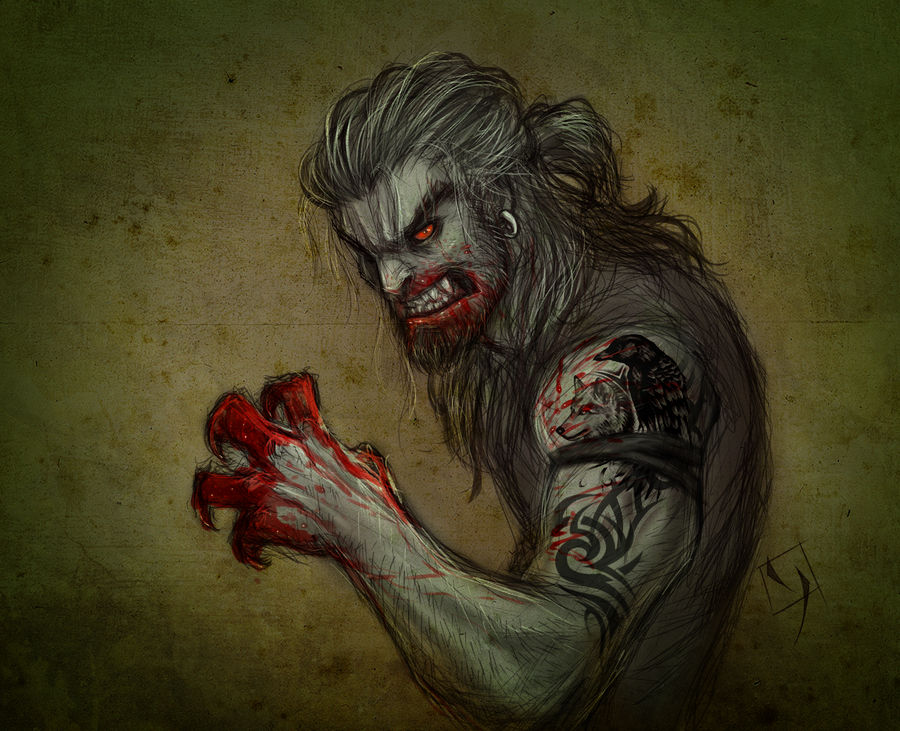Henry Longfellow’s “Musician’s Tale: The Saga of King Olaf” from his Tales of the Wayside Inn appears on the surface to be little more than a retelling and versification of the Old Norse-Icelandic saga Heimskringla which includes accounts of King Olaf Tryggvason. Of course, in the process, Longfellow adapts the medieval story honoring converter-king Olaf Tryggvason in his modern English translation suited for American audiences and his poem is mediated through Samuel Laing’s translation which Longfellow used as a model. Situating the poem in its the historical context, I would argue, highlights some of the rhetorical implications surrounding early American works of medievalism, such as Longfellow’s “The Saga of King Olaf.”
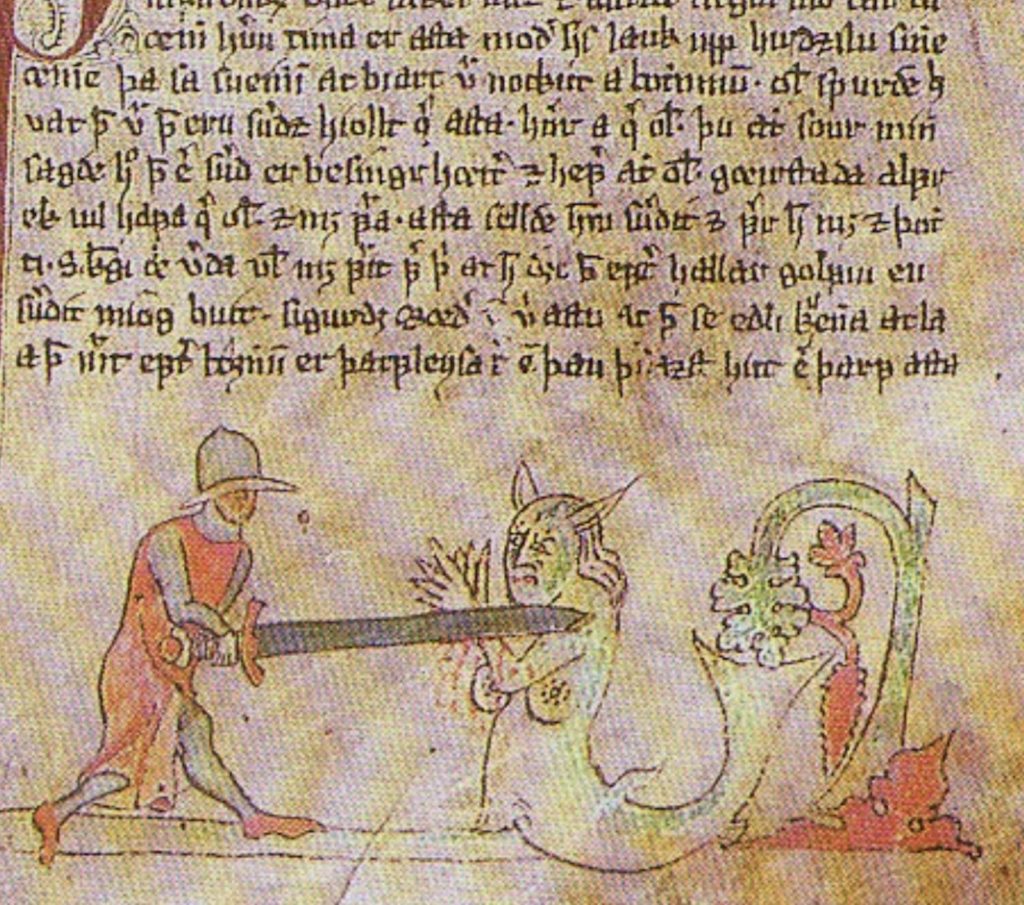
Archaic diction, especially medieval English terms and compounds, adorn the epic poetic retelling of the saga, such as the line “Through weald, they say, and through wold,” which include two alliterating terms “weald” [a forest] and “wold” [a wooded hill], both deriving from the Old English word wold meaning “wilderness,” and this embeds archaism into the poem.
In the previous blog, I included the opening stanza of the epic poem, “The Challenge of Thor” which Olaf then answers:
“And King Olaf heard the cry,
Saw the red light in the sky,
Laid his hand upon his sword,
There he stood as one who dreamed;
And the red light glanced and gleamed
On the armor that he wore;
And he shouted, as the rifted
Streamers o’er him shook and shifted,
“I accept thy challenge, Thor!”
This initiates the presentation of Olaf as a violent converter and warrior of Christ, which makes him an enemy of indigenous Scandinavian religion.
Religion continuously causes tension in the poem. When Queen Sigrid, whom Olaf pursues as his queen, refuses to convert to Christianity, he beats her in punishment, demonstrating again his use of violent conversion.
“A footstep was heard on the outer stair,
And in strode King Olaf with royal air.
He kissed the Queen’s hand, and he whispered of love,
And swore to be true as the stars are above.
But she smiled with contempt as she answered: “O King,
Will you swear it, as Odin once swore, on the ring?”
And the King: “O speak not of Odin to me,
The wife of King Olaf a Christian must be.”
Looking straight at the King, with her level brows,
She said, “I keep true to my faith and my vows.”
Then the face of King Olaf was darkened with gloom,
He rose in his anger and strode through the room.
“Why, then, should I care to have thee?” he said,–
“A faded old woman, a heathenish jade!
His zeal was stronger than fear or love,
And he struck the Queen in the face with his glove.“
This section, surely designed to demonstrate Olaf’s Christian zeal, reveals to Sigurd how abusive a husband he would be, and her decision not to wed him, while couched in fidelity to her indigenous beliefs, could have just as much to do with the violence he displays toward her as a result of her assertion of her voice and her commitment to her beliefs.
Olaf’s violence persists as he converts the pagans—frequently called warlocks and witches—but Longfellow seems to applaud the deliverance of his enemies for “thus the sorcerers were christened!”
Held up as validation of his conversionary conquests, Olaf finds the ghost of Odin, and proclaims the Allfather dead:
“King Olaf crossed himself and said:
“I know that Odin the Great is dead;
Sure is the triumph of our Faith,
The one-eyed stranger was his wraith.”
Longfellow’s narrative takes this a step further later in the poem,
“All the old gods are dead,
All the wild warlocks fled;
But the White Christ lives and reigns,
And throughout my wide domains
His Gospel shall be spread!”
On the Evangelists
Thus swore King Olaf.

When it comes to human sacrifice, Olaf threatens that if the pagan practice continues, then it will be the upper not the lower class offered as sacrifices to the gods, and in making this threat of violence against the aristocracy, convinces them to give up the practice.
“Such sacrifices shalt thou bring;
To Odin and to Thor, O King,
As other kings have done in their devotion!”
King Olaf answered: “I command
This land to be a Christian land;
Here is my Bishop who the folk baptizes!
“But if you ask me to restore
Your sacrifices, stained with gore,
Then will I offer human sacrifices!
“Not slaves and peasants shall they be,
But men of note and high degree,
Such men as Orm of Lyra and Kar of Gryting!”
Then to their Temple strode he in,
And loud behind him heard the din
Of his men-at-arms and the peasants fiercely fighting.
There in the Temple, carved in wood,
The image of great Odin stood,
And other gods, with Thor supreme among them.
King Olaf smote them with the blade
Of his huge war-axe, gold inlaid,
And downward shattered to the pavement flung them.
At the same moment rose without,
From the contending crowd, a shout,
A mingled sound of triumph and of wailing.
And there upon the trampled plain
The farmer Iron-Beard lay slain,
Midway between the assailed and the assailing.
King Olaf from the doorway spoke.
“Choose ye between two things, my folk,
To be baptized or given up to slaughter!”
And seeing their leader stark and dead,
The people with a murmur said,
“O King, baptize us with thy holy water.”
Even the notoriously unruly Thangbrand, described repeatedly as “Olaf’s Priest” and credited with Christianizing Iceland through violence, is praised for his efforts and paralleled with Olaf’s missionizing work:
All the prayers he knew by rote,
He could preach like Chrysostome,
From the Fathers he could quote,
He had even been at Rome,
A learned clerk,
A man of mark,
Was this Thangbrand, Olaf’s Priest.
He was quarrelsome and loud,
And impatient of control,
Boisterous in the market crowd,
Boisterous at the wassail-bowl,
Everywhere
Would drink and swear,
Swaggering Thangbrand, Olaf’s Priest
In his house this malcontent
Could the King no longer bear,
So to Iceland he was sent
To convert the heathen there,
And away
One summer day
Sailed this Thangbrand, Olaf’s Priest.Of course, when met with resistance from those still adhering to indigenous cultural practice, Thrangbrand resorts to violence, in accordance with his benefactor:
Hardly knowing what he did,
Then he smote them might and main,
Thorvald Veile and Veterlid
Lay there in the alehouse slain.
“To-day we are gold,
To-morrow mould!”
Muttered Thangbrand, Olaf’s Priest.Much in fear of axe and rope,
Back to Norway sailed he then.
“O King Olaf! little hope
Is there of these Iceland men!”
Meekly said,
With bending head,
Pious Thangbrand, Olaf’s PriestThe final line of this stanza is repeated twice in the poem, communicating the violent nature of Olaf’s mission and emphasizing the brutality associated with his Christianization of the indigenous cultural practice.
In their temples Thor and Odin
Lay in dust and ashes trodden,
As King Olaf, onward sweeping,
Preached the Gospel with his sword

The ethnonationalist overlay, as well as situating this saga retelling as a tale in colonial America, parallels the violent Christianization of indigenous peoples in North America, extending from the earliest colonial period to the ongoing American “Indian wars,” which the United States government was conducting, and which would not conclude until after the Civil War. “White Man’s Burden” justifications loomed large, and literature such as Longfellow’s “Musician’s Tale” support the continued Christianization and Westernization of indigenous cultures in the United States as around the globe to European colonial powers.
Although primarily revered as a scholar and poet, Longfellow was also an abolitionist who supported the anti-slavery movement in the mid-nineteenth century with both his art and his resources, and in 1842 write Poems on Slavery in an effort to draw attention to the inhumane cruelty of slavery, and he contributed financially to abolitionist organizations and individuals. Additionally, Longfellow was intrigued by indigenous peoples, and Longfellow’s most famous poem, The Song of Hiawatha, tells a fictionalized tale in part inspired by Ojibwe legend, but likely influenced by nationalistic epic projects, such as the Finnish Kalevala. Of course, Longfellow’s goal to include Anishinaabe legend in American literary canon could be viewed as inclusive in that it offers Anishinaabe peoples representation that might help preserve and celebrate their cultural heritage. However, Longfellow’s poem, perhaps unconsciously or subconsciously, reinforces harmful stereotypes and corroborates assimilation attempts by missionaries and government Indian agents to Anglicize indigenous people, which worked to erase cultural practices and identities.
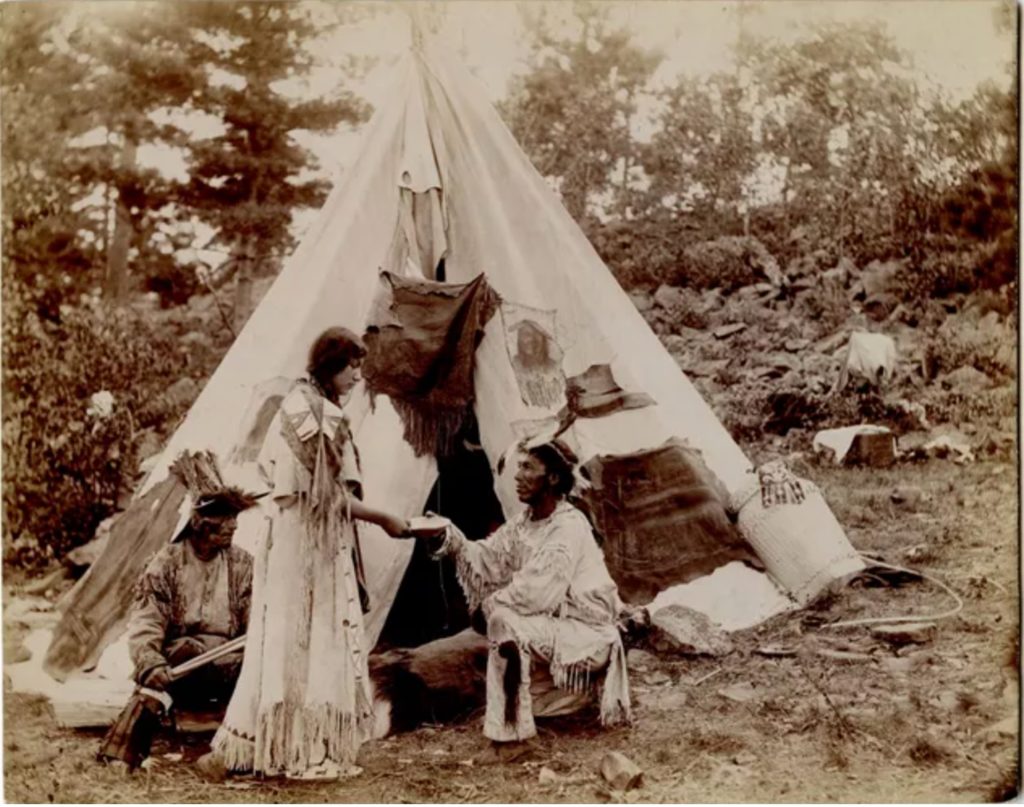
Longfellow’s interest in King Olaf I aligns him with other romantic antiquarians, but the rhetoric that emerges from a retelling of an Old-Norse Icelandic saga as a tale told in the cozy Wayside Inn in colonial Massachusetts creates an ethnonational link with medieval Europe and a religious model for conversion subjugation of indigenous peoples and belief systems by force and through an overt threat of violence. Since the advent of early modern European colonialization, efforts to Westernize indigenous people in North America were part of the same tradition of civilizing heathens through violent missionizing, just as certain early medieval Christianizing kings, such as Olaf I and Charlemagne, practiced conversion by the sword.
Longfellow articulates a melancholy nostalgia and romantic reverence for indigenous people, stating:
“As population advances westward, the plough-share turns up the wasted skeleton; and happy villages arise upon the sites of unknown burial-places. And when our native Indians, who are fast perishing from the earth, shall have left forever the borders of our wide lakes and rivers, and their villages have decayed within the bosom of our western hills, the dim light of tradition will rest upon those places, which have seen the glory of their battles, and heard the voice of heir eloquence;—and our land will become, indeed, a classic ground.”
However, the use of pronouns—us and them—demonstrates Longfellow’s view that the time for the indigenous is over as United States continues expanding west, an idea that remains toxic to the numerous, yet all-too-invisible, indigenous communities who resides in every state in the union.

Moreover, Longfellow’s medievalism participates in a broader social trend that serves to connect America with Europe through a shared historical and ethnonationalist identity. This rhetorical implication and paralleling create an historical allegory and provides the rationale for acts of genocide perpetrated by the American government and European colonists against indigenous peoples in North America, and the “New World” more broadly. It further reinforces as well, the New World—Old World rhetorical connection. Like many medieval theologians parallel the Old Testament with the New Testament, and at times use the Old Testament as a source of prophecy, Christianization of the indigenous Old World of the pagan North serves as a prophetic roadmap for Manifest Destiny and American westward expansion, which frequently employ violence and committed acts of genocide as a means of Christianizing and Westernizing indigenous peoples.
Richard Fahey, Ph.D.
Medieval Studies
University of Notre Dame

